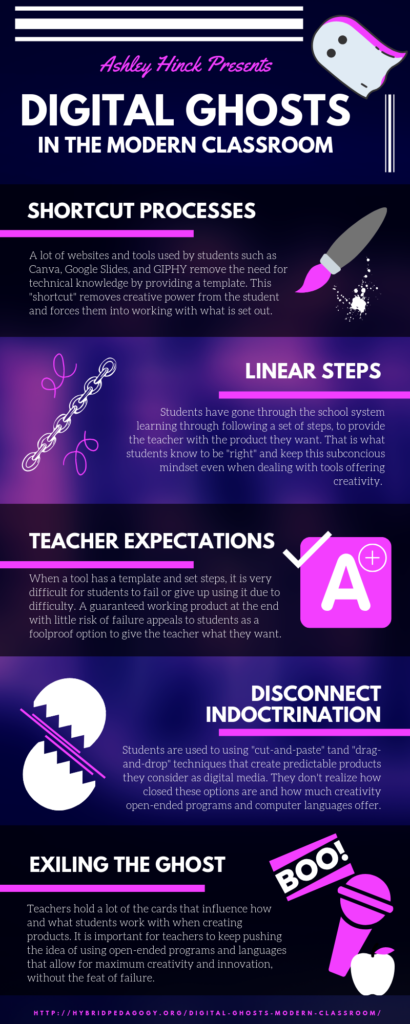I read the article “Digital Ghosts in the Modern Classroom” by Ashley Hinck. In the article, the author speaks of how existing tools and platforms, “shortcut” templates as she calls them, causes students to lose creativity and just do what is required to complete assignments by creating a desirable product for the teacher. She claims students have been indoctrinated to follow a set of steps to reach an end goal without the high potential of failure and mistakes, and that mindset has lead them into losing creativity and simply following the mold set out for them for success. She encourages teachers to give students the open-ended tools and languages that will not limit their creative ability and allow them to create without a guaranteed result.
I decided on this article due to the topic directly relating with my experiences and interests. I use a wide variety of template tools and platforms in everyday life, both for school and leisure to create digital products, as well as having prior experience working with open-ended language. I chose to represent the article with an infographic using Canva as a way to show the creative potentials of a “shortcut” template identified in the article.

I agree with Hinck that students have been trained to think a certain way when it comes to completing assignments and projects as they made their way through their schooling, and that it may have hindered their bold creative ability. I also agree that open-ended programs and languages should be encouraged to students. In terms of limited creativity, there is no arguing that template websites and platforms offer less creative potential than open technologies. However, I do not believe that they should be a requirement over existing template tools and platforms. Not every student will share the same exuberant passion for digital media and with a finite amount of time, spending it trying to come up with something from scratch that can be easily achieved with an existing tool should not be forced upon students.

I think the option should absolutely be there for students who choose to explore this creative endeavor, with an incentive that will not put them at a disadvantage when compared to their peers using templates, such as an extended due date if needed to compensate for potential mistakes and errors in the process. But for a lot of students, I believe what the current options offer are more than capable for what they are aiming to do, and should still be an option for use.
When creating my Canva infographic, despite all the options, it was difficult at first to find one to suit my vision. I knew I wanted a modern look with a vaporwave aesthetic for my infographic to look professional and represent the digital side of the article, but didn’t know exactly how I wanted it to look. By finding one that represents the colour scheme I wanted but couldn’t come up with in my mind, it was perfect. It offered me something a blank canvas couldn’t have given me, and that was a spark of inspiration and ideas. It got my creative mind flowing with possibilities as I explored the available elements and tools I could use with it, of which were completely unrelated to what was already shown on the default setting of the infographic. So from just my experience using Canva for this project, I can say that if a student is not happy with what they see available to them, it will not stymie their creativity and cause them to settle for something less than they desire.

I noticed, through my own experiences using these platforms and tools, they open up another aspect of thinking in students – it works on their creativity, flexibility and adaptability. By finding ways to change their product to suit what they can use while keeping the quality of their work at top tier, it enhances all three of those traits. For example, a student who is not able to remove the background or change the colour of a photo on one tool is able to use a seemingly unrelated tool, such as Microsoft Word, to perform that task. Also, with Canva specifically, there are limitations on what photos and elements are allowed for use on a free account. This may seem debilitating to creativity at first, but afterwards you learn how to work with different elements you can use and get very creative with them to get your desired result.
An analogy I have to this situation are musical instruments. There are many musicians who practice their craft and create their art using instruments that already exist and are widely available, like saxophones, trumpets, and flutes. However, the instrument of their selection limits them on what sounds are possible. Should musicians be inventing their own instruments to use to open all possibilities for them to get their perfect desired sound? Or are they able to push their musical talents to their full potential by using existing tools? I believe the second one.

In the end, I feel that while it is important not to stifle the creative world of students, it is also just as important not to force students out of their ability range with open-ended programs and languages lacking limitations. After all, some creativity is better than none, and that “some” is actually a lot. I think a happy medium is to give students the option to use existing templates and tools or open-ended programs and languages, and make the conditions fair for whichever option they select. There are still many creative possibilities in the realm of the “shortcut” templates and they are very capable of producing work that students can be proud of – like I am.
